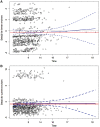Exploring causality of the association between smoking and Parkinson's disease
- PMID: 30462234
- PMCID: PMC6659366
- DOI: 10.1093/ije/dyy230
Exploring causality of the association between smoking and Parkinson's disease
Abstract
Background: The aim of this paper is to investigate the causality of the inverse association between cigarette smoking and Parkinson's disease (PD). The main suggested alternatives include a delaying effect of smoking, reverse causality or an unmeasured confounding related to a low-risk-taking personality trait.
Methods: A total of 715 incident PD cases were ascertained in a cohort of 220 494 individuals from NeuroEPIC4PD, a prospective European population-based cohort study including 13 centres in eight countries. Smoking habits were recorded at recruitment. We analysed smoking status, duration, and intensity and exposure to passive smoking in relation to PD onset.
Results: Former smokers had a 20% decreased risk and current smokers a halved risk of developing PD compared with never smokers. Strong dose-response relationships with smoking intensity and duration were found. Hazard ratios (HRs) for smoking <20 years were 0.84 [95% confidence interval (CI) 0.67-1.07], 20-29 years 0.73 (95% CI 0.56-0.96) and >30 years 0.54 (95% CI 0.43-0.36) compared with never smokers. The proportional hazard assumption was verified, showing no change of risk over time, arguing against a delaying effect. Reverse causality was disproved by the consistency of dose-response relationships among former and current smokers. The inverse association between passive smoking and PD, HR 0.70 (95% CI 0.49-0.99) ruled out the effect of unmeasured confounding.
Conclusions: These results are highly suggestive of a true causal link between smoking and PD, although it is not clear which is the chemical compound in cigarette smoking responsible for the biological effect.
Keywords: EPIC; NeuroEPIC4PD; Parkinson’s disease; causal inference; cohort study; passive smoking; smoking; smoking patterns.
© The Author(s) 2018. Published by Oxford University Press on behalf of the International Epidemiological Association.
Figures



References
-
- Li X, Li W, Liu G, Shen X, Tang Y.. Association between cigarette smoking and Parkinson’s disease: a meta-analysis. Arch Gerontol Geriatr 2015;61:510–16. - PubMed
-
- Checkoway H, Powers K, Smith-Weller T, Franklin GM, Longstreth WT Jr, Swanson PD.. Parkinson’s disease risks associated with cigarette smoking, alcohol consumption, and caffeine intake. Am J Epidemiol 2002;155:732–38. - PubMed
-
- Ritz B, Ascherio A, Checkoway H. et al. Pooled analysis of tobacco use and risk of Parkinson disease. Arch Neurol 2007;64:990–97. - PubMed
-
- O’Reilly EJ, McCullough ML, Chao A. et al. Smokeless tobacco use and the risk of Parkinson’s disease mortality. Mov Disord 2005;20:1383–84. - PubMed

